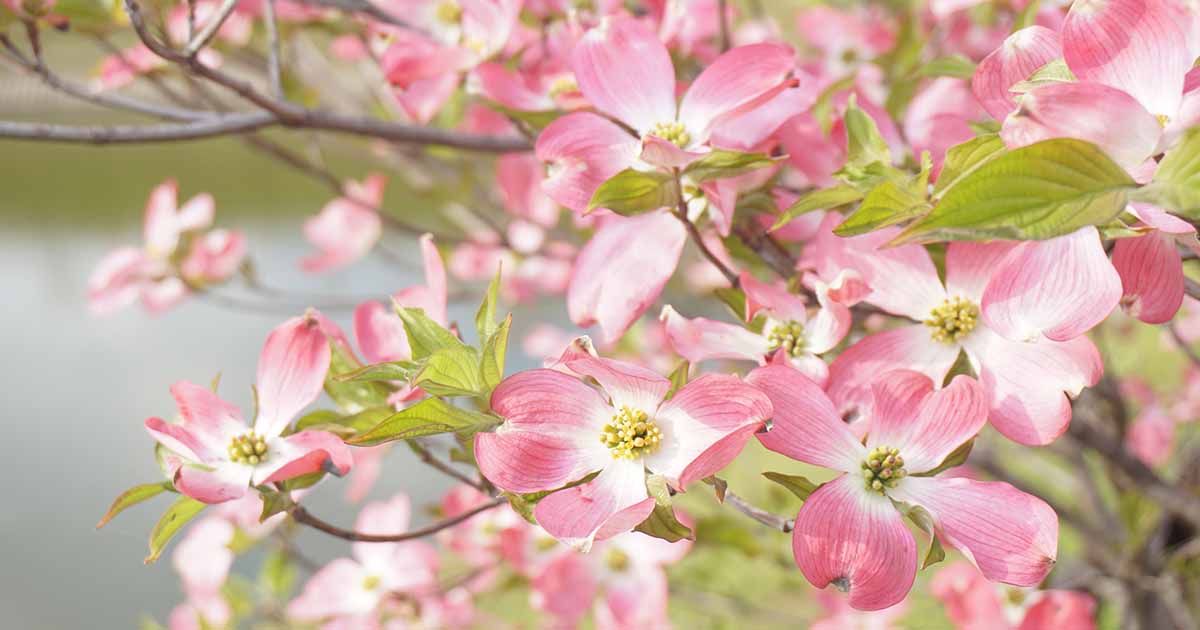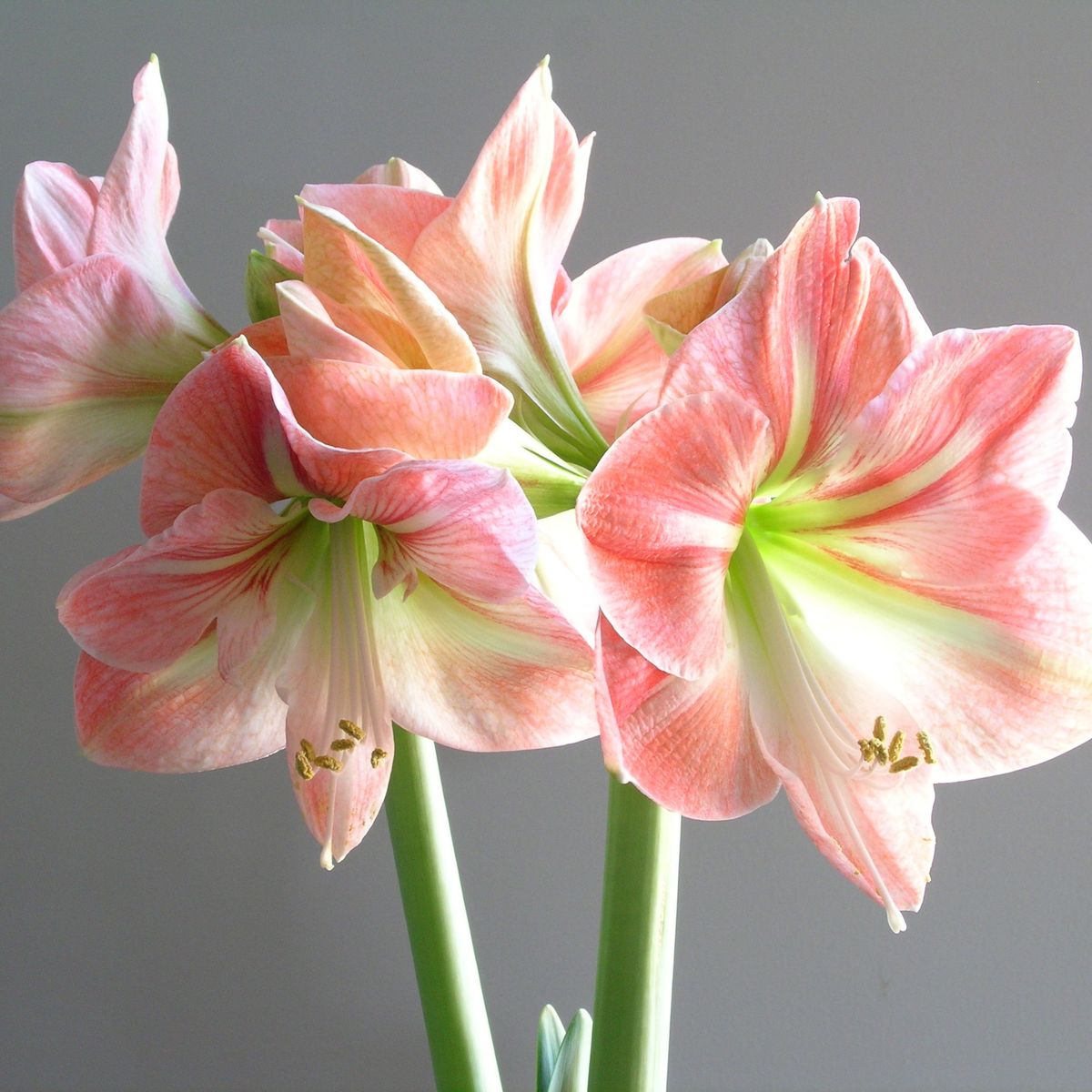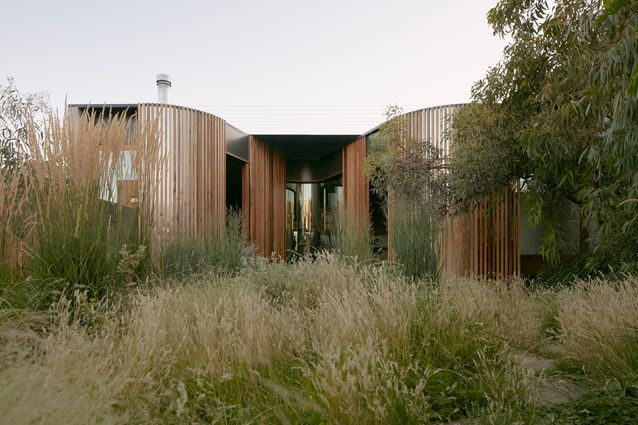6. Elegantissima
C. alba ‘Elegantissima’ is a shrub for Zones 3 to 8. It is a cultivated variety of the Siberian or Tatarian species and has the classic bright red stems one would expect, but that’s not all!
The foliage is variegated and consists of green leaves with cream margins. Clusters of small, fragrant white blossoms are an elegant complement.
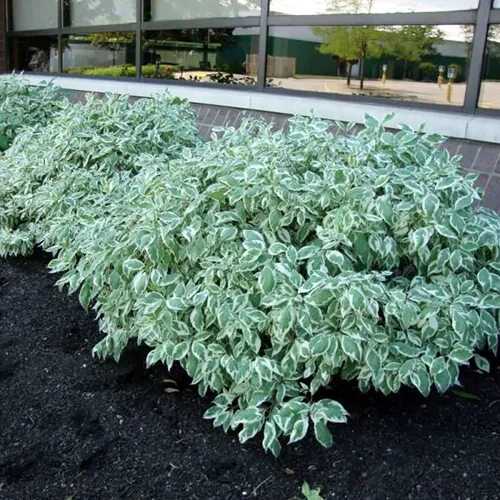
‘Elegantissima’
In autumn, white drupes and gold, pink, and red leaves contribute their appeal to the seasonal landscape.
Expect mature heights of nine to 10 feet and a spread of eight to 10 feet.
‘Elegantissima’ is available from Nature Hills Nursery.
See our guide to growing Tatarian dogwoods for more details. (coming soon!)
7. Elizabeth Lustgarten
C. kousa ‘Elizabeth Lustgarten’ is a cultivated variety of the Asian kousa dogwood for Zones 5 to 9.
Kousas bloom late in the spring, are exceptionally hardy, and have showy petal-like bracts that are more pointed than rounded, making them appear almost star-like.
This cultivated variety is a weeping tree with artfully cascading branches and white flowers.
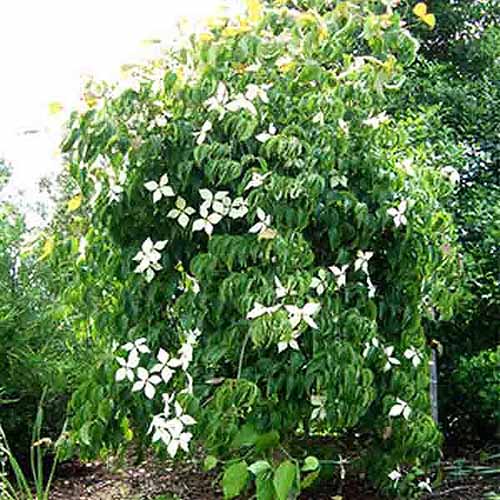
‘Elizabeth Lustgarten’
The green foliage shades to rich orange, red, and yellow tones in the fall. Edible bumpy red drupes complement the exceptional display.
Expect mature dimensions of 12 to 15 feet tall and 15 to 18 feet wide.
‘Elizabeth Lustgarten’ is available from Nature Hills.
Learn more about kousa dogwood in our growing guide.
8. Firebird
Bright reddish-pink blossoms precede the emergence of the tri-color green, pink, and white foliage of Firebird™, C. florida ‘Fircomz,’ a tree for Zones 5 to 9.
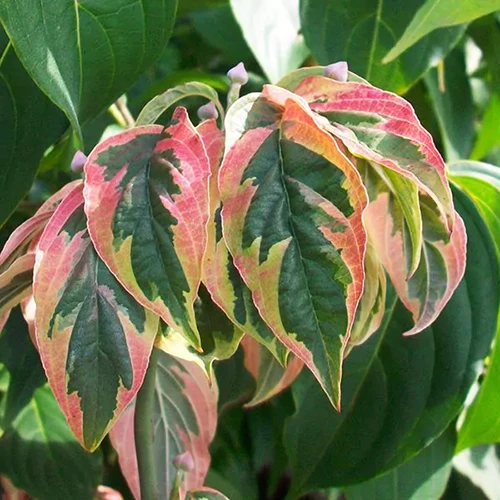
Firebird™
When fall is in the air, red drupes add to the festive display as the colorful foliage deepens to purple hues.
Mature dimensions are 15 to 18 feet tall and wide.
Firebird™ is available from Nature Hills Nursery.
9. Gray Twig
Gray twig, aka gray or gray-stemmed dogwood, C. racemosa, formerly C. foemina subsp. racemosa, is a native shrub for Zones 2 to 8.
It has red emergent foliage that shades to gray-green in summer and deep red in autumn.
The stems are gray rather than the usual brown.
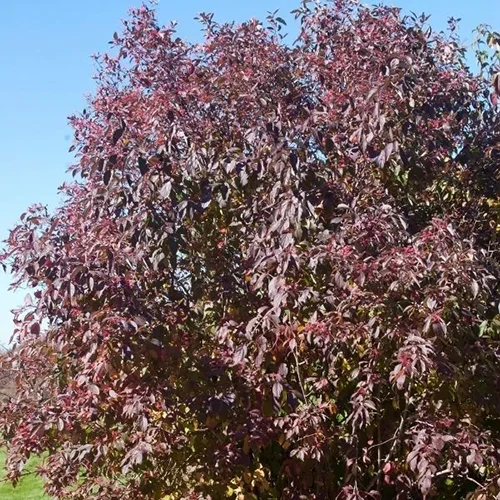
Gray Twig
Clusters of small, starry white flowers give way to white drupes in the fall. The pedicels or fruit stems are an eye-catching bright red.
This species prefers moist soil but tolerates dry conditions well. Mature dimensions are 10 to 15 feet tall and wide.
Gray twig is available from Nature Hills Nursery.
10. Isanti
C. sericea ‘Isanti’ is a red osier cultivar appreciated for exceptional cold hardiness and a compact form. It’s suited to cultivation in Zones 3 to 8.
Spring brings clusters of small, star-like white blossoms. The fall display is a bold combination of white drupes and deep red foliage.
In winter, bare red stems continue to capture the attention of passersby.
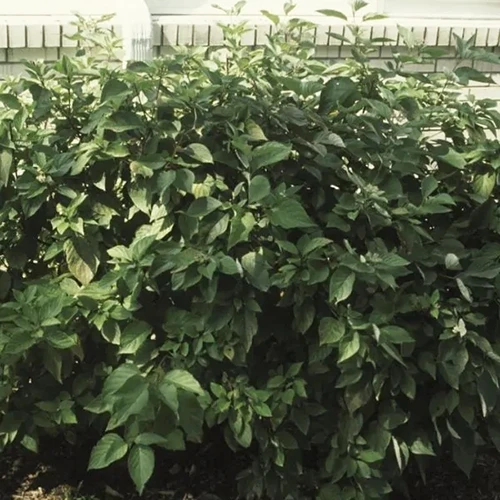
‘Isanti’
This cultivar is especially at home in wet soil and grows to a height and width of five to six feet.
‘Isanti’ is available from Nature Hills Nursery in #3 and #5 containers, and bare roots.
11. Ivory Halo
Ivory Halo, C. alba ‘Bailhalo’, is a red twig Tatarian cultivar with variegated green leaves outlined in cream margins. It grows in Zones 3 to 7.
Star-shaped, white flowers cluster atop the striking foliage in spring.
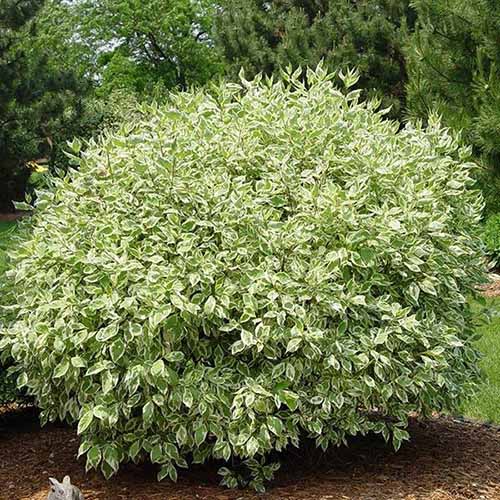
Ivory Halo
Fall brings white drupes and leaves that bronze to burgundy, purple, and red hues. And in winter, the classic red stems catch the eye across snowy landscapes.
Mature dimensions are five to six feet tall and wide.
Ivory Halo is available from Nature Hills Nursery.
12. Muskingum
Muskingum®, C. racemosa ‘Muszam,’ is a cultivated variety of native gray dogwood with a compact, ground-covering stature. It grows in Zones 4 to 7.
This shrub’s emergent spring foliage is red. It turns gray-green by summer. Starlike, white blossoms appear in clusters, and the bark is gray instead of brown.
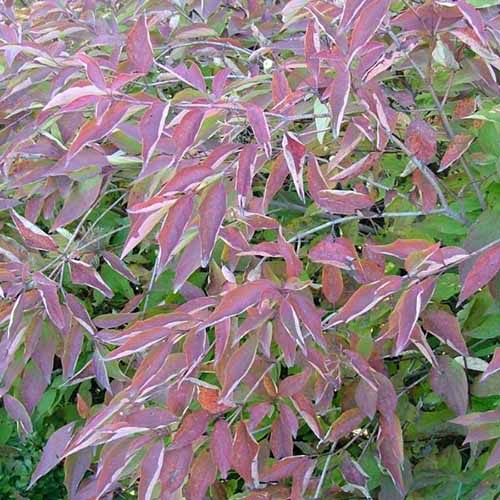
Muskingum
By fall, the foliage shades to deep red, accented by white drupes.
Mature dimensions are two to three feet tall and four to five feet wide.
Muskingum® is available from Nature Hills Nursery in #3 containers.
13. Neon Burst
Neon Burst™, C. alba ‘Byboughen,’ is a shrub for Zones 2 to 7 with vivid yellow summer foliage.
It’s a cultivated variety of the Tatarian or Siberian dogwood known for its bright red stems. To keep them looking their best, prune out the oldest and showcase the youngest.

Neon Burst
Clusters of small white blossoms in spring and white drupes in fall are less showy, as the foliage is the star of this cultivar’s show.
From springtime yellow, it bronzes to shades of burgundy, gold, orange, purple, and red in the fall.
Expect dimensions of four to five feet tall and wide.
Neon Burst™ is available from Nature Hills Nursery in #3 containers.
14. Pacific
The Pacific dogwood, C. nuttallii, is also known as mountain or Canadian dogwood.
It’s a western native species suited to cultivation in Zones 7 to 9 that offers what flowering dogwood (C. florida) does for the country’s eastern side.

This species grows as a tree with horizontal, tiered branches and upturned tips.
The spring foliage is green. Showy flowers have white petal-like bracts and provide the classic layered look of an eastern C. florida species or cultivated variety.
Bright red or orange drupes complement the fall foliage’s orange, red, and yellow tones.
This species tolerates black walnut juglone toxicity and clay soil. Mature dimensions are 15 to 40 feet tall with a spread of 10 to 25 feet.
15. Pagoda
The native pagoda dogwood, C. alternifolia, grows as a shrub or tree in Zones 4 to 8.
It has the classic horizontal, tiered branches with upturned tips we’ve come to identify with native varieties.
Clusters of small, starry white blossoms adorn the branches atop the green foliage in spring.
Unlike most dogwoods, which have leaves opposite one another, pagoda has alternating leaves, hence the Latin species name, “alternifolia.”
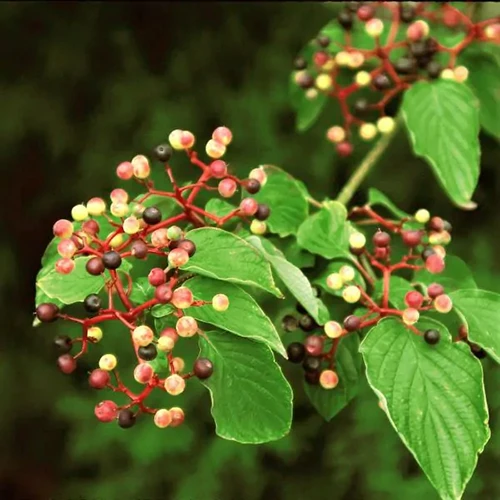
Pagoda
Toward season’s end, bluish-black drupes borne on red pedicels perch attractively on reddish-purple autumn foliage.
This species is tolerant to juglone. Mature dimensions are 15 to 20 feet tall with a spread of 20 to 25 feet wide.
Pagoda dogwood is available from Nature Hills Nursery.
See our guide to growing pagoda dogwoods for more details. (coming soon!)
16. Red Osier
Native red osier, C. sericea, formerly C. stolonifera, is a stunning red-stemmed shrub from which many cultivars are derived. It grows in Zones 2 to 8.
In the spring, clusters of small, starlike, white blossoms and green leaves decorate the landscape.
Fall’s chill changes the foliage to deep reds, oranges, and purples. White drupes punctuate the seasonal hues.
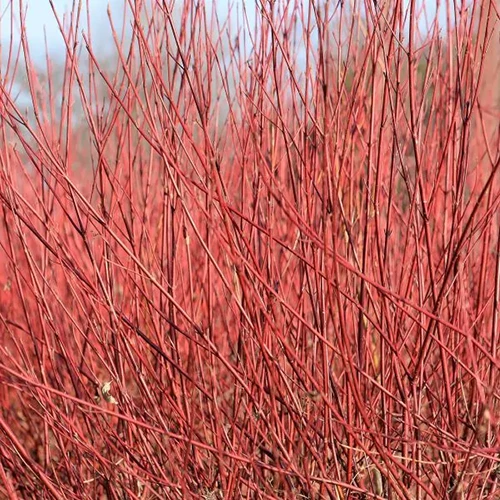
Red Osier
And in winter, the young stems are brilliant red and create a sensation in a snowy landscape. Trimming out older branches to promote new growth ensures a colorful display.
Tolerant of wet conditions and clay soil, this species grows to heights of eight to 12 feet and widths of eight to 10 feet.
Red osier dogwood is available from Nature Hills Nursery.
17. Roughleaf
Roughleaf dogwood, C. drummondii, is a native tree for Zones 5 to 8 with rough textured gray-brown bark that shows exceptionally well in snowy winter scenes.
In spring, it boasts clusters of small, starry white flowers and green leaves. Fall deepens the foliage to burgundy, purple, and red. White drupes accent the rich hues.

Roughleaf
This species tolerates wet soil. Expect mature dimensions of eight to 15 feet tall and wide.
Roughleaf dogwood is available from Audubon via Nature Hills.
18. Satomi
C. kousa ‘Satomi’ is a cultivated variety of Asian kousa dogwood with outstanding features for every season. It grows in Zones 5 to 9.
Late spring flowers blush with showy pink, pointed bracts atop lush dark green foliage, adorning the graceful, horizontal branches with layers of cheerful color.
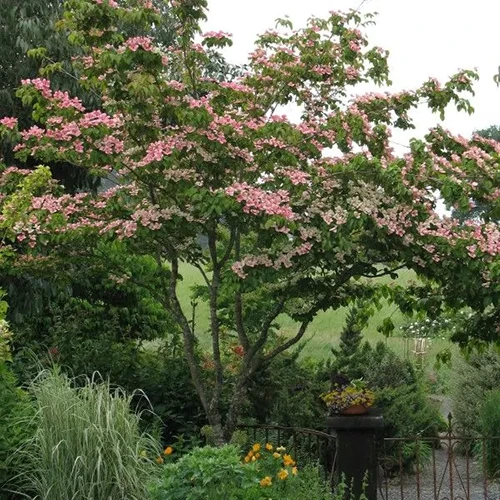
‘Satomi’
This species has excellent disease resistance and offers an alternative to native flowering dogwood in areas where anthracnose is prevalent.
In autumn, edible but not very palatable bumpy red drupes in combination with red foliage create a vivid display.
Mature dimensions are 15 to 30 feet tall and wide.
‘Satomi’ is available from Nature Hills.
19. Scarlet Fire
Scarlet Fire® aka C. kousa ‘Rutpink,’ is a kousa cultivar for Zones 5 to 9 developed at Rutgers University. Its richly saturated spring and fall color is fabulous.
The late spring display consists of pointed bracts in a show-stopping shade of fuchsia-pink.
When the foliage sprouts, it has a purplish cast before maturing to dark green.
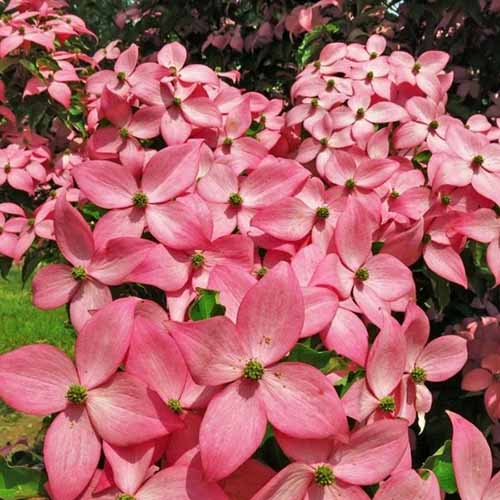
Scarlet Fire®
Pinkish-red bumpy drupes follow the blossoms, along with red and orange autumn leaves. And in winter, the grayish-brown exfoliating bark continues to command attention.
Exceptionally tolerant of cold, heat, pests, and disease, this cultivar is a stand-out specimen that achieves mature dimensions of 20 to 25 feet tall and 15 to 20 feet wide.
Scarlet Fire® is available from Nature Hills.
20. Silky
Silky dogwood, C. amomum, is a songbird favorite with inky blue berries and red fall foliage that’s suited to cultivation in Zones 4 to 8.
Small flowers are star-like and grouped in clusters. Spring and summer foliage is a lush green.
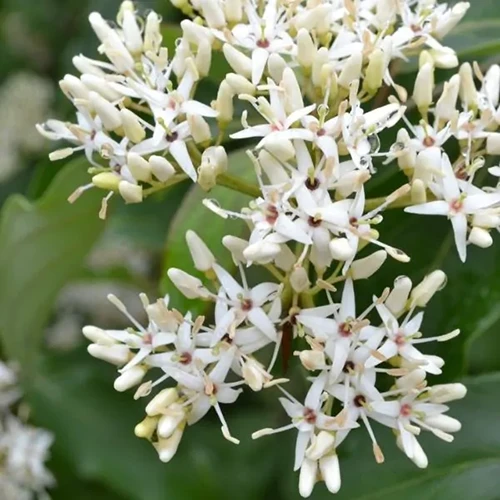
Silky
This species tolerates wet soil. Without pruning, the lower branches readily root to form dense thickets for wildlife to inhabit.
Expect a mature height of six to eight feet and a spread of six to nine feet.
Native silky dogwood is available from Audubon via Nature Hills.
21. Swamp
A subspecies of silky dogwood, native swamp dogwood (C. amomum subsp. obliqua) is a tree or shrub for Zones 4 to 8.
New spring shoots are purplish and mature to green. There are clusters of starry white flowers in springtime and inky blue drupes at season’s end.
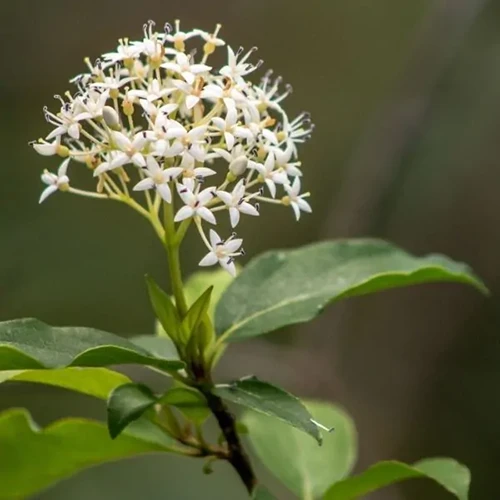
Native Swamp
This plant features no distinctive fall color and tolerates wet soil. Mature dimensions are six to 10 feet tall and five to eight feet wide.
Native swamp dogwood is available from Audubon via Nature Hills.
22. Venus
Venus® (Cornus ‘Kn30 8’) is a remarkable cultivated variety for Zones 6 to 9. It’s a hybrid of three cultivars: C. kousa ’Chinensis’ x C. nuttalii ’Goldspot’ x C. kousa ’Rosea.’
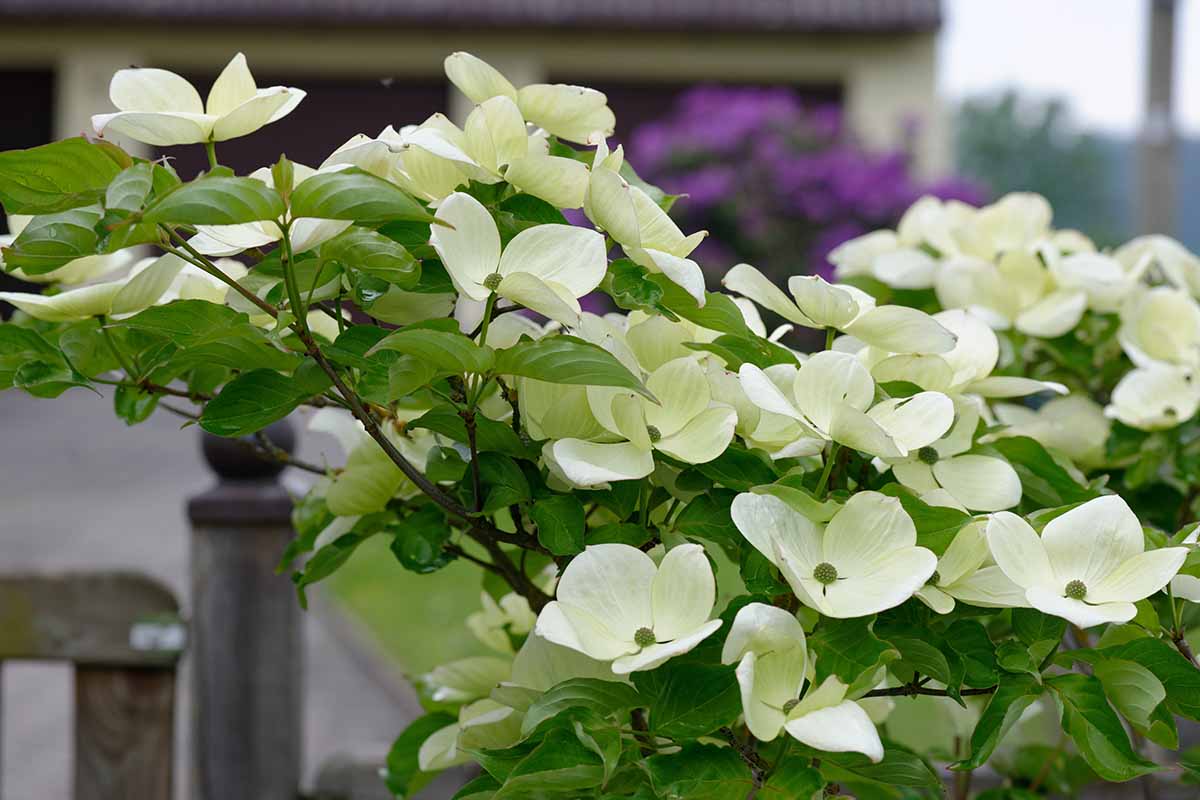
This cultivar is part of the Jersey Star® series produced at Rutgers University. It is exceptionally hardy, highly resistant to anthracnose and powdery mildew, and drought tolerant.
This robust shrub or tree has showy, white flowers (bracts) six inches across, lush dark green foliage, and tiered, horizontal branching for a spectacular late spring display.
Drupes are kousa-style, red, round, and bumpy.
This variety reaches a mature height of 14 to 18 feet, and a width of 18 to 24 feet.
23. Yellow Twig
Yellow or golden twig, C. sericea Flaviramea,’ is a cultivated variety of red osier with bright yellow stems instead of red ones that delivers year-round ornamental value in Zones 3 to 8.
Pruning out old branches helps to maintain optimal color.
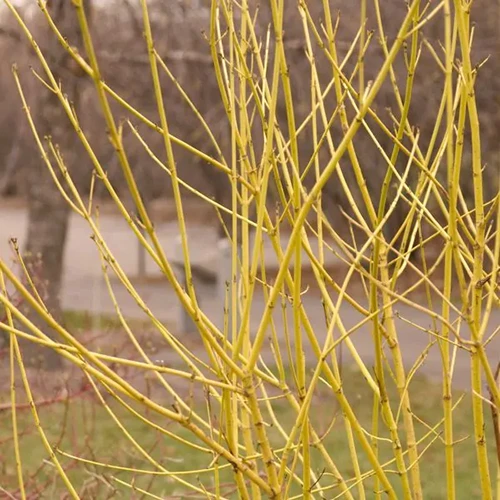
Yellow Twig
In the spring, enjoy clusters of starry, white blossoms against a backdrop of dark green leaves. By fall, white berries appear, and the foliage deepens to burgundy, purple, and red tones.
These shrubs tolerate clay and wet soil. Mature heights are six to eight feet tall with an equal spread.
Yellow twig is available from Nature Hills Nursery.
Decorative and Dependable Dogwoods
Whether you prefer trees, shrubs, or subshrubs, you’re sure to find new favorites in this list of 23 best dogwood varieties.

For best results, choose species and cultivars suited to your growing zone.
Plant them in locations with full sun to part shade and well-draining soil, and allow ample room to achieve mature dimensions without overcrowding.
In addition to their decorative qualities, like lighting up springtime gardens with blossoms, summer with lush leaves, fall with drupes and bronzed foliage, and winter with striking bare stems, dogwoods are a dependable source of food and shelter for wildlife.
Do you grow dogwoods? Which are your favorites? Share your answers in the comments section below.
If you enjoyed this round-up of dogwoods and want to read more about landscape trees, we recommend the following:

